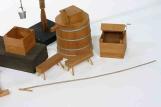2
This exhibit portrays the collection crafted by John McNeely McCrea. Reproductions of a variety of pioneer homes, furnishings, buildings and other structures were created by McCrea during the last twenty years of his lifetime - 1937 to 1957. Each model, whether a tiny flycatcher on a mantel or a large grist mill is replicated in detail and true to the original. The collection was formerly with the Royal Ontario Museum and is now with Museums and Heritage Services, Culture Division, City of Toronto. This exhibit showcases a large portion of the total display. Mr. McCrea with his craftsmanship has left a permanent legacy of the "wooden age" of pioneer Ontario.4
When a small boy, John McNeely McCrea spent much time in his father's cabinet shop where he learned how to use tools and the glue pot; and, of course, there were always strewn around many odd pieces of discarded wood. At the age of seven he was making bats, bows and arrows, sleighs and rail tracks, but the lack of funds prevented his finishing a steam engine of which he had dreamed. When still young he often visited his Uncles' farms where he became conversant with farm life and farming tools and implements. He went with his father on numerous trips into the country, and had an eye for accuracy and detail. His memory was exceptionally retentive, and so the foundation was laid for "MODEL MAKING" in later life.After being convinced that the models would instruct, give pleasure and revive the traditions of pioneer life, John McNeely McCrea took seriously to making models later illustrated in the book, HISTORY IN WOOD. In addition to reading every book on pioneer life of which he had heard, he wrote or talked to everyone from whom he thought he could get factual information. He often received much where least was expected.
He did not foresee the size of his present collection and later realized that he should have had more tools, a good camera to photograph all the parts and the completed article, and that he should have kept a detailed record of each production, i.e. where he obtained the information, the date of the making, the time spent on each and the cost of the material and the obtaining of the information.

